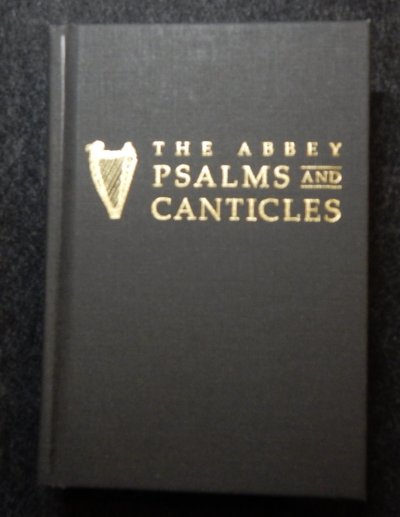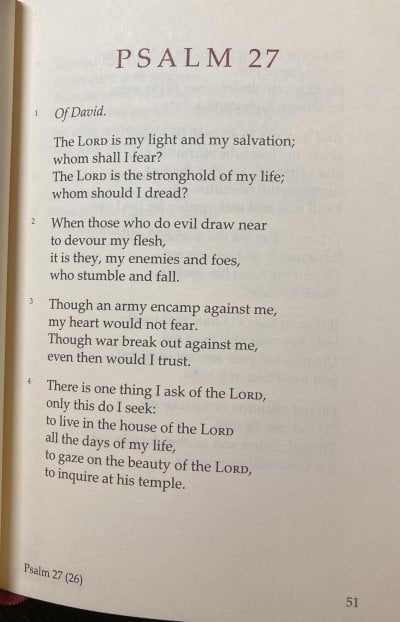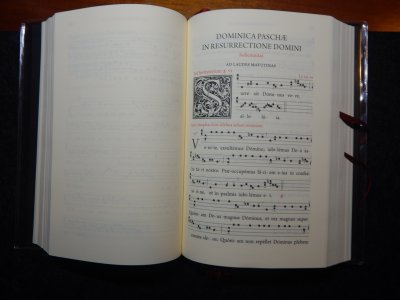New Liturgical Books
The Abbey Psalms and Canticles

Despite COVID-19, and all the delays that have come in its wake, 2020 has proved to be an important year for Catholic liturgy. In February the United States Conference of Catholic Bishops published the definitive version of the revised Grail Psalms translation which will form the base of the revised Liturgy of the Hours and also be used in the new Lectionary.
Oddly, for a text which has not yet been fully "launched" in the United Kingdom, this translation is now circulating in three distinct versions: the "Revised Grail Psalms" prepared by the Benedictine monks of Conception Abbey, which was approved by the Holy See for liturgical use in 2010; the text edited by Dom Henry Wansbrough and incorporated into the "Revised New Jerusalem Bible" last year; and now this "Definitive Version" which has been brought out after the US Catholic Bishops obtained the copyright in 2018. There are a surprising number of changes to the 2010 text, some of them a little jarring. For example, in Psalm 117 the familiar stanza
"It is better to take refuge in the LORD / than to trust in man; / it is better to take refuge in the LORD / than to trust in princes."
has become, "It is better to take refuge in the LORD / than to trust in anyone else; / it is better to take refuge in the LORD / than to trust in princes."
Generally, though, it is a beautiful translation and this new printing has the added advantage of being published with the Canticles from the Old and New Testaments used daily in the liturgy. These, like the psalms, are the final version approved for use in the US in future liturgical books.

The book is handsomely printed on thick cream paper, cased in a slate-grey hard cover. It is available from the USCCB website in the US or from Amazon in the UK.
Antiphonale Romanum.

Gregorian chant is normally associated with monastic liturgy, but following on from their work on the Antiphonale Monasticum, the monks of Solesmes have now published a two volume antiphonal to accompany the Roman Office. Volume 2 came out in 2009 and gives all the texts needed to sing the office of Vespers (Evening Prayer) on Sundays and the greater feasts. Volume 1 appeared earlier this year and gives the texts and music for the Invitatory and Lauds (Morning Prayer). Unlike the corresponding monastic volumes, these are designed to stand alone and include the Gregorian hymns, antiphons, psalms, readings, intercessions and prayers. They are in Latin throughout, although of course it would be possible to use the musical items alongside the English-language Liturgy of the Hours. It is a shame that the short office of Compline was not included in the Vespers volume.
Available from the online shop of Les Editions de Solesmes.
The Neumz App.
Although not strictly a liturgical book, the Neumz App, which was launched on the First Sunday of Advent (29th November 2020), is a valuable resource for anyone who wants to deepen their knowledge of the Gregorian musical heritage of the Catholic Church. It is part of a massive project, and makes available more than 7,000 hours of Gregorian Chant. Engineers of Odradek Records are recording the Benedictine nuns of the Abbey of Jouques in their daily office through the course of the entire three year liturgical cycle. The free version of the app allows you to listen to the daily office sung in its entirety. Subscribers have access to all the texts on demand (selected by date), with recording, musical texts and translations available simultaneously. The promotional price is 6.99 Euros a month. Two thirds of the revenues from subscriptions will go to the sisters to support the community of Jouques and their foundation of Notre Dame de l'Ecoute in Benin. You can download the Neumz app from App Store or Google Play, or subscribe to their YouTube channel.
More information can be found on the Neumz website.
The Praglia Antiphonale Monasticum.

In October the monks of Praglia in Northern Italy published the second volume of their long awaited Antiphonal. It is now complete in two volumes: the first, 'De Tempore', has all the music required for the Seasons of the Year and the Sundays in Ordinary Time; the second, 'De Sanctis', has the antiphons, hymns and responsories for the Sanctoral, including the common offices and also the Latin psalm antiphons for the ferial office. They are designed to accompany 'Schema B', a Benedictine arrangement of the psalms which spreads the Psalter over one week without repetitions (the Roman Office spreads the Psalter over a four week cycle).
Earlier choir books produced by Praglia had been in Italian. These two volumes are clearly intended for a more international market and are entirely in Latin, apart from the preface which is presented in Latin, Italian and English. They are beautifully printed, with sturdy bindings and gilt edges but, unlike the Antiphonale Romanum, would need to be supplemented with additional liturgical books for the readings, prayers and intercessions. The Italians have these in Praglia's 'Liturgia Monastica delle Ore', but since the Praglia books take these items from the Roman Office, the gaps could be filled by the Latin edition of the 'Liturgia Horarum' or from the English Liturgy of the Hours. The Solesmes 1981 edition of the 'Psalterium Monasticum' can be adapted to Schema B and has Gregorian antiphons for all the psalms and canticles.
The Praglia Antiphonale Monasticum has been produced by a team of musicologists who have based their restoration of the authentic melodies of the chants on the manuscripts of Hartker preserved at St Gall in Switzerland. These date from the years 980-1011. Where material is lacking, these manuscripts have been supplemented by by others from across Europe, but for each melody, only one manuscript has been chosen and faithfully transcribed. The publication of this antiphonal is a major event, since it brings to an end over 50 years of enforced musical improvisation for any monastery trying to follow Notker Fueglister's Schema B. Some of the Gregorian melodies are notably different from those in the the Solesmes antiphonal, and it may be a challenge for communities to learn this new repertoire.
Sample recordings of the chant (Registrazioni mp3), together with more information on the project, can be heard on a new website dedicated to the Novum Antiphonale Monasticum (go to the "More ..." tab).
The recordings can be downloaded as zipfiles. They are arranged by liturgical season and cross referenced to the Antiphonal.
These new liturgical choir books compiled for the Benedictine Schema B are available from the website of the Monastero di Praglia. Details of prices and availability are given on the website.
Fr. Ambrose Flavell, updated 22nd February 2021. My thanks to Sr Maria Ruth Malagoli, osb, of the Abbazia benedettina Mater Ecclesiae, Isola San Giulio - Novara for additional information on the New Monastic Antiphonal.



